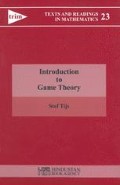Abstract
A two-person bargaining game is an ordered pair (F, d), where F is a subset of ℝ2 and where d is a point in ℝ2. The elements of F are called feasible outcomes (utility pairs), which the players can reach if they cooperate. In case of no cooperation the disagreement outcome d results, with utility d i for player i ∈ {1, 2}. The problem is on which outcome to agree. Many solutions are proposed and much work has been done in this field (Cf. A. Roth (1979), A. Roth (1985), H. Peters (1992)). The basis was laid by J. Nash (1950). Let Ɓ be the family of bargaining games (F, d) with the following properties:
-
(B.1)
F is non-empty, convex, closed and comprehensive,1
-
(B.2)
{x ∈ F | x ≥ d} is bounded,
-
(B.3)
there exists an x0 ∈ F with x0 > d.
Access this chapter
Tax calculation will be finalised at checkout
Purchases are for personal use only
Preview
Unable to display preview. Download preview PDF.
Author information
Authors and Affiliations
Rights and permissions
Copyright information
© 2003 Hindustan Book Agency
About this chapter
Cite this chapter
Tijs, S. (2003). Bargaining games. In: Introduction to Game Theory. Texts and Readings in Mathematics. Hindustan Book Agency, Gurgaon. https://doi.org/10.1007/978-93-86279-17-0_17
Download citation
DOI: https://doi.org/10.1007/978-93-86279-17-0_17
Publisher Name: Hindustan Book Agency, Gurgaon
Print ISBN: 978-81-85931-37-1
Online ISBN: 978-93-86279-17-0
eBook Packages: Mathematics and StatisticsMathematics and Statistics (R0)

